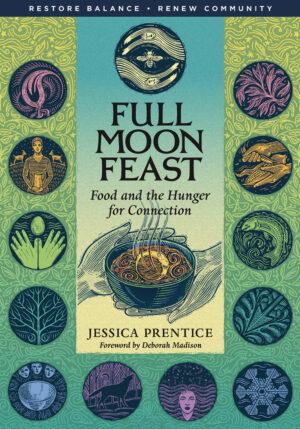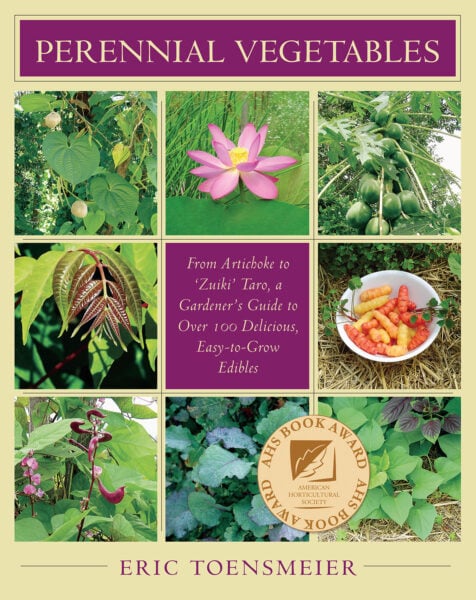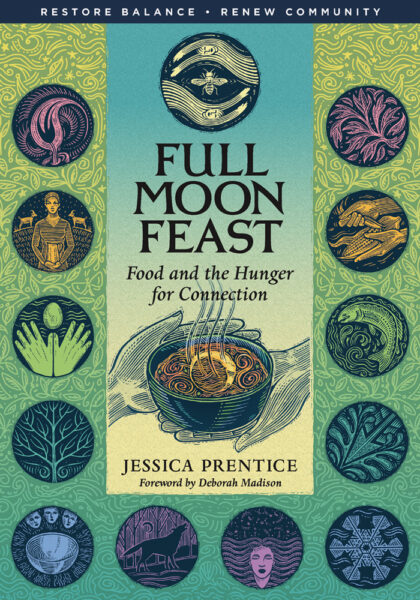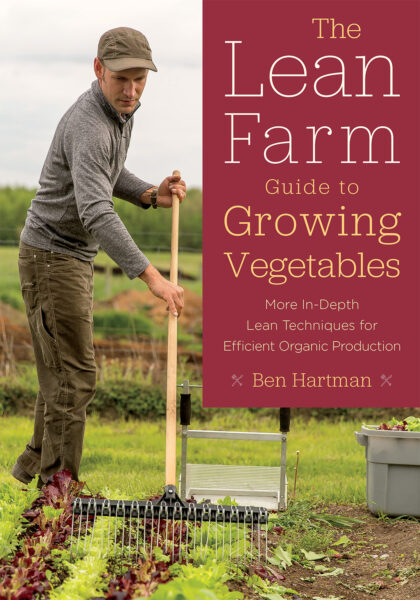Hunger Moon-Inspired Recipe: Roasted Root Vegetables

If you love to cook with fresh produce but happen to live in a climate where it’s nearly impossible to access during the winter months, we feel ya! Here in the northeast, chilling winds and heaps of snow make it hard to leave the house, let alone grow fresh produce, but that doesn’t mean we have to give up on delicious, hearty meals. Even in the winter months, root vegetables are in abundance at the market and with this easy Roasted Root Veggie recipe you may just forget about the chill outside.
The following excerpt is from Full Moon Feast by Jessica Prentice. It has been adapted for the web.
In the deep of winter, when the earth in the North has been covered with snow and ice for many moons already, comes the Hunger Moon. This late-winter lunar cycle was called the Hunger Moon by many peoples in various languages, but always for the same reason—the frozen land yielded little to eat, and game was often scarce.
European American settlers in the New England area adopted the name as one of the full-moon names used in the Old Farmer’s Almanac. They adapted it from Native American calendars, particularly the ones used by the various Algonquin peoples that lived in the northeastern areas of what is now the United States, from New England to the Great Lakes.
Indigenous names for the moon were as varied as the languages that they came from, but often carried similar meanings. The Choctaw name for this moon is translated Little Famine Moon; a Cherokee name is the Bony Moon or the Bone Moon because it was said that there was so little food, people gnawed on bones and ate bone marrow soup to survive. All of these names lament the scarcity of food. In the days before refrigeration and wide-scale shipping of produce and staples, hunger often became a real threat by the end of a long winter. Both hunter-gatherer societies and farming peoples subsisted on very little after months of bitter cold.
Roasted Root Vegetables
Serves 1 person for every 3/4 cup of vegetables
Ingredients
You can use any of the following vegetables, in any combination:
Celery root (aka celeriac), peeled
Parsnip
Rutabaga
Turnip (either white, purple, or golden)
Beets (either red, golden, or chiogga), peeled
Carrots
Potatoes (any color)
Sweet potatoes
Olive oil
Salt
Pepper
Procedure
- Preheat the oven to 475° F.
- Peel any vegetables that have thick or blemished skin. Cut the vegetables into a uniform dice—1/2-inch dice, 3/4-inch dice, or 1-inch dice—or just quarter or half the vegetables, if they are on the small side. The only important thing is that all the pieces are about the same size. The smaller the size, the faster they will cook. The larger the size, the longer they will take. Half-inch-dice vegetables can roast in 20 minutes or so. Figure about 1 cup of vegetables per person as a side dish.
- Coat all the vegetables with olive oil. I do this by getting the pan I am going to use—a cast-iron pan, sheet pan, or roasting pan, preferably metal—and pouring in a generous amount of oil. I put my hands right in the oil and spread it all around the bottom of the pan, getting my hands oily. Then I pick up the vegetables in handfuls, rub them with my hands to cover them in a thin layer of olive oil, and drop them in the pan.
- Ideally, prepare enough vegetables for a single layer in the pan you are using. You do not want to pile up the vegetables. If you have too many to fit in a single layer, get another pan, grease it with olive oil, and put the rest of the vegetables in there.
- Sprinkle salt and freshly ground black pepper over the vegetables. It is hard to say how much salt to use. It is better to use too little than too much, because you can add more later. You also don’t want to overwhelm the flavor of the vegetables with salt. So just sprinkle lightly at this stage, until you’ve roasted vegetables often enough to know what you are doing.
- Put the pan in the oven on the top rack and leave for at least 15 minutes before opening the oven, then check them. They should be starting to brown. You can use a spatula to mix and flip the vegetables in the pan, or just shake the pan. Stick a fork in the vegetables to see how tender they are. If they feel pretty tender, try eating one. Check them regularly like this until you are happy with the results. Add more salt and pepper if you like and serve with fish, meat, or egg dishes, and a fresh salad.
Recommended Reads
Recent Articles
Chances are, you’ve seen cattails growing on the edge of your local lake or stream at least once or twice. Instead of just passing these plants, try foraging for and cooking them to create delicious seasonal dishes! The following excerpt is from The New Wildcrafted Cuisine by Pascal Baudar. It has been adapted for the…
Read MoreGarlic mustard: while known as “invasive,” this plant can be consumed in its entirety and has great nutritional value. Plus, the garlic-flavor is a perfect addition to any recipe that calls for mustard! The following are excerpts from Beyond the War on Invasive Species by Tao Orion and The Wild Wisdom of Weeds by Katrina…
Read MoreOh, honeysuckle…how we love thee. If only there was a way to capture the sweet essence of this plant so we could enjoy it more than just in passing. Luckily, foraging and some preparation can help make that happen! Here’s a springtime recipe that tastes exactly like honeysuckle smells. The following excerpt is from Forage,…
Read MoreIntroducing…your new favorite brunch dish! This whole broccoli frittata is packed with fresh, wildcrafted flavors that are bound to help you start your day off on the right foot. The following is an excerpt from The Forager Chef’s Book of Flora by Alan Bergo. It has been adapted for the web. RECIPE: Whole Broccoli Frittata…
Read MoreWondering where to forage for greens this spring? Look no further than hedges, which serve as natural havens for wild greens and herbs! The following is an excerpt from Hedgelands by Christopher Hart. It has been adapted for the web. Food from Hedges: Salads and Greens Let’s start by looking at all the wild foods…
Read More









